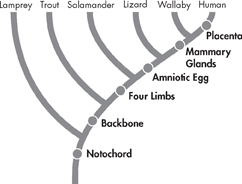Standardized Test Prep
Multiple Choice
Which of the following is NOT a mollusk?
leech
squid
clam
snail
Which of the following invertebrates have segmented bodies?
flatworms
roundworms
cnidarians
annelids
All animals have some form of body symmetry EXCEPT
sponges.
jellyfishes.
worms.
arthropods.
Which of the following groups can be classified as nonvertebrate chordates?
sponges
tunicates
fishes
all of the above
Many scientists think that birds evolved from
mammal-like reptiles.
amphibians.
mammals.
dinosaurs.
Which of the following is NOT a characteristic of reptiles?
scaly skin
eggs with shells
lungs
mammary glands
Which of the following are hominoids?
all mammals
all primates
humans only
all great apes
When did the first true mammals appear?
Cretaceous Period
Triassic Period
Cenozoic Era
Carboniferous Period
Questions 9–11 Refer to the following cladogram.

Which characteristic is shared by humans, wallabies, and trout?
placenta
notochord
four limbs
mammary glands
Which animals have the closest evolutionary relationship, as shown by the cladogram?
humans and wallabies
humans and lizards
humans and lampreys
humans and trout
A valid conclusion from this cladogram is that
salamanders, trout, and lampreys all have a backbone.
four limbs appeared in vertebrate evolution before the notochord appeared.
humans and lampreys share a common ancestor.
mammary glands appeared in vertebrate evolution after the placenta appeared.
Open-Ended Response
What is the difference between a hominoid and a hominine?
| Question | 1 | 2 | 3 | 4 | 5 | 6 | 7 | 8 | 9 | 10 | 11 | 12 |
|---|---|---|---|---|---|---|---|---|---|---|---|---|
| See Lesson | 26.1 | 26.1 | 26.1 | 26.2 | 26.2 | 26.2 | 26.3 | 26.2 | 26.2 | 26.2 | 26.2 | 26.3 |
Table of Contents
- Formulas and Equations
- Applying Formulas and Equations
- Mean, Median, and Mode
- Estimation
- Using Measurements in Calculations
- Effects of Measurement Errors
- Accuracy
- Precision
- Comparing Accuracy and Precision
- Significant Figures
- Calculating With Significant Figures
- Scientific Notation
- Calculating With Scientific Notation
- Dimensional Analysis
- Applying Dimensional Analysis




